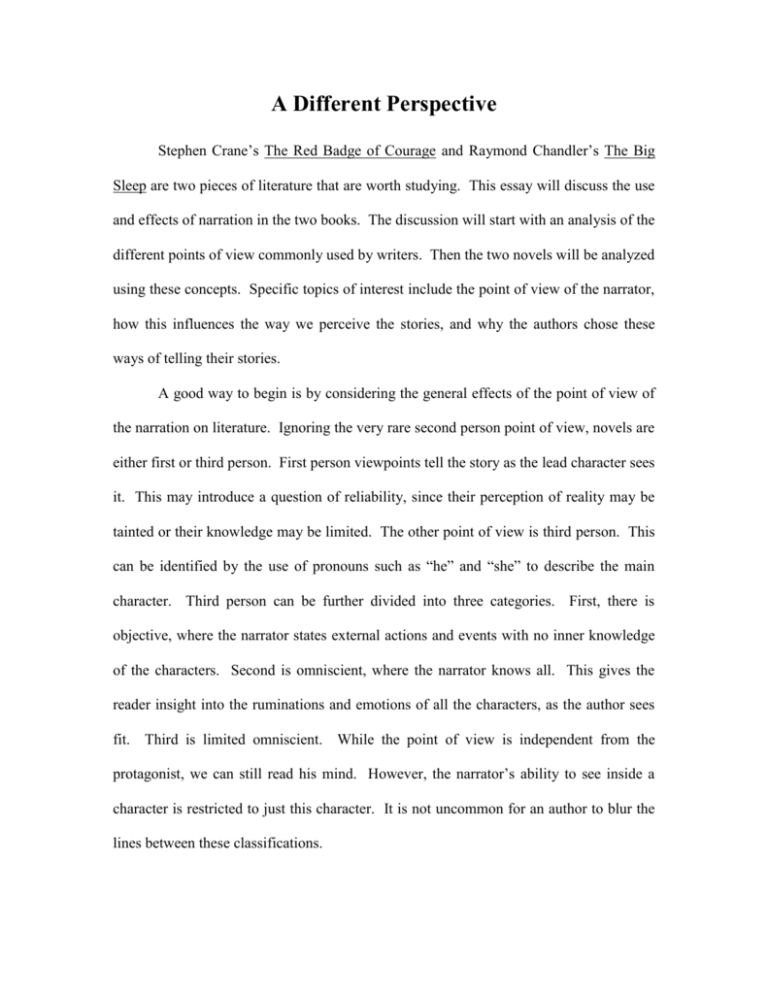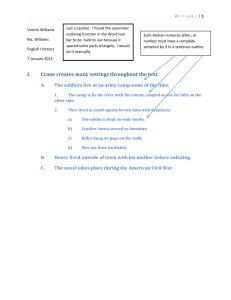Essay 3 - Red Badge and Big Sleep
advertisement

A Different Perspective Stephen Crane’s The Red Badge of Courage and Raymond Chandler’s The Big Sleep are two pieces of literature that are worth studying. This essay will discuss the use and effects of narration in the two books. The discussion will start with an analysis of the different points of view commonly used by writers. Then the two novels will be analyzed using these concepts. Specific topics of interest include the point of view of the narrator, how this influences the way we perceive the stories, and why the authors chose these ways of telling their stories. A good way to begin is by considering the general effects of the point of view of the narration on literature. Ignoring the very rare second person point of view, novels are either first or third person. First person viewpoints tell the story as the lead character sees it. This may introduce a question of reliability, since their perception of reality may be tainted or their knowledge may be limited. The other point of view is third person. This can be identified by the use of pronouns such as “he” and “she” to describe the main character. Third person can be further divided into three categories. First, there is objective, where the narrator states external actions and events with no inner knowledge of the characters. Second is omniscient, where the narrator knows all. This gives the reader insight into the ruminations and emotions of all the characters, as the author sees fit. Third is limited omniscient. While the point of view is independent from the protagonist, we can still read his mind. However, the narrator’s ability to see inside a character is restricted to just this character. It is not uncommon for an author to blur the lines between these classifications. Which styles are used by Crane and Chandler? The Red Badge of Courage follows Henry, a young soldier, as he fights in the Civil War. While the plot definitely centers on Henry, the narrator is third person with generally limited omniscience. As stated above, that means the narrator is separate from Henry but is aware of his thoughts and feelings. While the narrator can make observations beyond those of Henry, he cannot “see” inside any other characters. There are occasional exceptions to this, such as the opening section where the narrative briefly follows the tall soldier. Some may refer to the narrator as the invisible Crane. The Big Sleep, however, is told through the eyes of the protagonist, Philip Marlowe. It is a first person narrative; we see the world exclusively through his eyes. We are, of course, aware of his thoughts and feelings but not directly aware of any other characters’ inside thoughts. At this point, we have a solid foundation to analyze each novel. First, we will examine The Red Badge of Courage. As stated above, Crane chose to tell the story with a third person, limited omniscient point of view. The plot follows Henry as he gains much maturity in very little time. By seeing Henry’s thoughts, we are aware that Henry is consumed with himself. In the beginning of the novel, he is quite immature. He has dreams of grandeur but has no idea of the work involved in becoming a hero. When he runs away, he convinces himself that everyone else knows he did it. However, in reality, actually nobody other than him knows that he ran. By the end of the novel, he has matured considerably. His perspective is changed such that he is aware that the universe does not care about him; his life is trivial in the grand scheme. At the end of the novel, he reflects on his growth: “He felt a quiet manhood, nonassertive but of sturdy and strong blood. He knew that he would no more quail before his guides wherever they should point. He had been to touch the great death, and found that, after all, it was but the great death. He was a man.” (Crane, p. 97) How does the novel’s point of view affect our perception of the story? At the beginning, the point of view can be credited for allowing the reader to easily see Henry’s naïveté. Crane refers to Henry as “the youth,” which further enforces his inexperience. Since Henry is not aware of his faults at this point, it would be harder to detect them from a first person narrative. The third person narrative also conveys a sense of sarcasm at the end of the text. Henry is quite proud of himself and his accomplishments at this point in the story. Is he right in feeling so? Careful readers may recognize that his sentiment is similar to that following the first battle. We know he was not mature at the start of the novel; is his path toward maturity complete by the end of the novel? As stated above, the narrator is first person in The Big Sleep; Philip Marlowe is the one telling the story. Marlowe is a private detective that meets many lascivious characters. Because of Marlowe’s character and integrity, he resists any temptations to follow their examples, although it is frequently hinted that he would have an easier life that way. After reading the book, the reader is left with warm thoughts for a man that lives a straight life in a crooked world. How does the point of view affect our perception of this text? By its nature, a first person narrative is tainted by the predisposition of the narrator. Marlowe views the world around him and sees many vices including deceit, sexual immorality, murder, and corruption. These ethics are generally accepted in our world. However, a third person may place a different emphasis on the situation. Marlowe mentions his habits of drinking and smoking, but there is little negative said about it. An outside observer with different beliefs might consider the detective to fit in with the muck that surrounds him. However, since Marlowe is telling the story, it is very easy for readers to accept his personal habits without a second thought. If the points of view of The Red Badge of Courage and The Big Sleep were altered, both the direct and metaphorical messages of the texts would be changed. The degree of the change is debatable. However, if Henry narrated The Red Badge of Courage, readers might think that the whole regiment actually did see him run away, and we probably would not be aware that most of the men were as scared as Henry. It is critical that the reader is aware of Henry’s growth through the novel, because that is the essence of the whole story. If The Big Sleep was told from a third person point of view with omniscience, the whole mystery could be revealed. Marlowe might not seem as impressive of a sleuth, and his flaws such as smoking and drinking would be seen in a different light. If the reader did not have respect for Marlowe, Chandler’s theme where the detective represents a knight would be lost. Thus, we can see that the narration of these texts is an integral piece in the conveyance of the author’s ideas.








